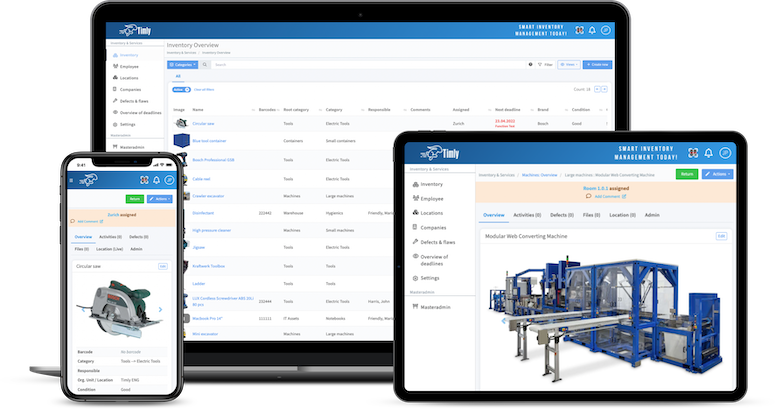Businesses of all sizes and across sectors have assets, ranging from IT equipment, office furniture, and work tools to machinery and vehicles. Add to this digital assets such as supplier contracts, software licenses, and staff qualifications and certifications. Keeping track of these physical and digital assets can quickly become a complex task for businesses, especially as many items require management for maintenance, allocation to staff or projects, and relationship with each other.
Navigating this complexity demands more than traditional method – it calls for innovative digital solutions. Enter companies like Timly, a leading provider in asset tracking software, which is at the forefront of revolutionizing asset management through cutting-edge digital technology.
Spreadsheets vs. software
Many companies have tried and still try to manage their tools and equipment using Excel spreadsheets. However, with the business world increasingly moving towards digital transformation, the need for sophisticated digital asset solutions has become more urgent. Also, the larger a company’s asset inventory, the more cumbersome managing it in spreadsheets gets. A simple question such as how to link equipment with the relevant maintenance logs and schedules is a case in point. Factor in the widespread adoption of remote working, and the challenges of knowing which staff member has what equipment, its condition, repair needs, and when maintenance is due – and the complexities assets tracking and management becomes more than evident.
Optimising resources
Timly know that the challenge facing businesses today extends beyond just tracking and managing equipment. As companies expand, the ability to effectively track physical assets becomes essential to maximise resource utilisation, avoid waste, unnecessary purchases, and prevent shortages. Consider basic items like desks and chairs — every facilities manager strives to operate in an efficient and lean manner. But achieving this efficiency is challenging without a robust asset tracking system in place. Additionally, the combination of on-site and remote working models demands an optimised real estate infrastructure that takes into account both occupancy and usage, adding another layer of complexity to asset management. This scenario is just one example. Similar issues exist across various departments within an organisation, from IT to HR to Health & Safety.
Ensuring compliance
Asset tracking, though complex, offers benefits that are far-reaching and often not immediately apparent. Take, for instance, the maintenance of everyday equipment like ladders and step ladders. Although it may seem niche, this is actually a crucial consideration in nearly every work environment, where personnel may at times work at height or engage in tasks with small but inherent risks. Ensuring safe working conditions is impossible with inadequately maintained equipment. Factors like improper operation, maintenance, storage, and safety protocols can lead to accidents and employee injuries. Clearly, no business wants this, nor to have to face health and safety violation complaints or regulatory issues.

Tracking across the business
Speaking of providing appropriate training to staff: managing records of their training, qualifications, and certifications for operating specific tools and machinery adds another layer of complexity to asset management. Linking the dots between equipment, their users, and both past and future maintenance schedules is no simple task. This intricate process requires meticulous attention to detail and a comprehensive system to ensure that all aspects are appropriately managed and up to date. It’s a vital part of ensuring not only the efficiency but also the safety and regulatory compliance of workplace operations
360° tracking solutions
In this context, 360° cloud asset tracking solutions are emerging as not just viable but indispensable tools for businesses aiming to maintain a holistic view of their company’s activities, especially in critical operational processes and tasks that require constant attention.
Firstly, cloud-based asset solutions offer universal accessibility from any device, anywhere. This ensures businesses always have the most up-to-date information and can grant access to their staff, who don’t require additional software or hardware. Secondly, advanced and intuitive tracking software, such as those provided by companies like Timly, leverages QR technology for tracking everyday equipment, tools, and other assets. This involves affixing small barcode labels to items and scanning them with any smart device’s integrated camera, whether a smartphone, tablet, or laptop.
![]()
Customisation and data safety
The best SaaS solutions for asset tracking stand out for their customisability and flexibility, enabling businesses to adapt them to their unique needs. Moreover data security is paramount, and cloud-based asset tracking solutions provide the benefit of secure data storage and management. Timly for instances relies on GDPR-compliant servers located in Europe.
Transforming operations
Clearly, this level of asset visibility and interconnectedness goes beyond mere monitoring business resources- it enhances operational efficiency, streamlining workflows, and enabling informed decision-making. Asset monitoring, tracking and management not only improves resource utilisation but also extend the lifecycle of assets, all while ensuring compliance with regulations and legal obligations.
Free consultation
For businesses looking to transform their asset management practices, embracing cloud-based solutions is a strategic step towards operational resilience and long-term growth. For those considering whether this is a viable option for their specific needs, Timly offers a free and non-binding online consultation.